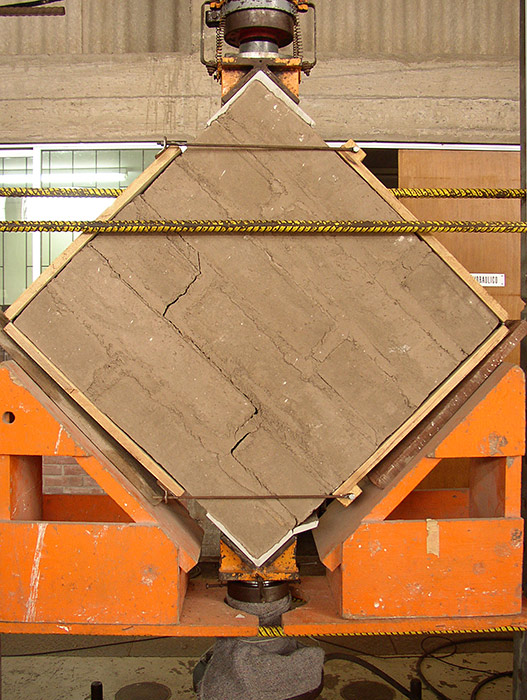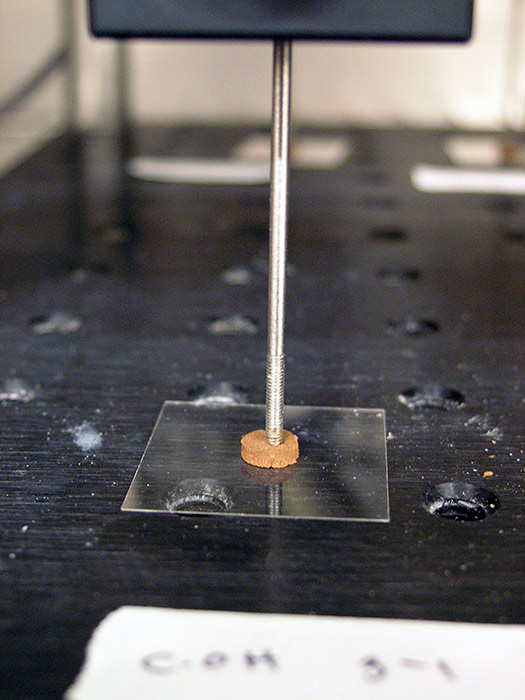Past Activities
Structural Grouting
The study and testing of grouts has been a topic of interest for the conservation community since the early 1970s. The compatibility of lime- or earth-based grouting formulations with adjacent materials has been considered in work carried out by the GCI at several sites but studies considering the efficiency of this method for seismic stabilization or the nature of the impact of a seismic event on the grout and/or its relationship with the original materials and structure are lacking. In an effort to address this issue, the EAI undertook a multidisciplinary program to analyze different methods of repairing seismically induced cracks.
In 2006 the Escuela de Ciencias e Ingeniería at the Pontificia Universidad Catolica del Peru (PUCP) started testing and bibliographical research to identify adequate structural grouting materials for adobe walls using locally available soil. The GCI then provide financial and technical support for a second research phase addressing both engineering and conservation issues. The objective was to compile information, conduct research, and to perform laboratory testing to identify and evaluate grouting materials that are compatible with original materials, structurally effective, and result in minimal impact on original fabric during a seismic event.
In August 2007 the EAI hosted an experts meeting in collaboration with PUCP in Lima to share knowledge and evaluate laboratory testing protocols and methodologies for the study of structural grouting in seismic areas. Meeting summary notes (5pp, PDF), are available. Participants in the 2007 Lima meeting have continued to exchange information, and a second experts meeting was held in July 2008 in Bath, England, as part of the VI International Conference on Structural Analysis for Historical Constructions.
Strategic Planning
In March 2009, the GCI organized a two-day Experts Workshop on the Study and Conservation of Earthen Architecture in the Mediterranean Region, in Villanovaforru, Sardinia for professionals with expertise in earthen architecture, construction, and conservation. The workshop, presented in partnership with the School of Architecture at the University of Cagliari in Sardinia, Italy; Escola Superior Gallaecia of Portugal; and CRATerre-ENSAG, and with the generous support of the province of Medio Campidano, was held in conjunction with Mediterra 2009: the 1st Mediterranean Conference on Earth Architecture.
The workshop provided a forum to discuss: the challenges facing the conservation and management of earthen sites—broadly interpreted to include archaeological sites, vernacular and monumental architecture, as well as, cultural landscapes where earth is a predominant feature—and earthen architecture for sustainable development.
Assessment of Ethyl Silicate Consolidants for Earthen Finishes
The Getty Conservation Institute in collaboration with the Architectural Conservation Laboratory (ACL) of the University of Pennsylvania (UPenn) assessed ethyl silicate-based consolidants and their effect on various clay-based surface finishes with the aim of providing information to conservators on which ethyl silicates are most appropriate for use with specific earthen finishes and under which conditions they can optimally be used.
Investigation at ACL/UPenn explored the behavior of earthen finishes after consolidation with proprietary ethyl silicate-based products when exposed to water in both liquid and vapor form. Results revealed differences in the performance of the ethyl silicates in terms of curing time, expansion and contraction, water repellency, and durability during wet-dry cycling. These differences indicate that the type of ethyl silicate used needs to be considered carefully before administering treatment and that the composition of the treatment material plays an important role in its performance.
Research at the GCI evaluated the behavior of formulated clay-based finish materials when treated with a selection of popular commercial consolidants. Treated materials were evaluated for appearance, mechanical properties, plasticity, response to water and environmental durability. Two clay types were used for sample preparation to assess their effect on the performance of ethyl silicate-based consolidants.
Page updated: July 2014



